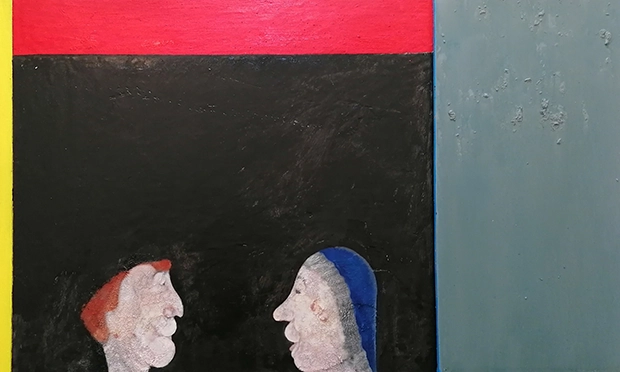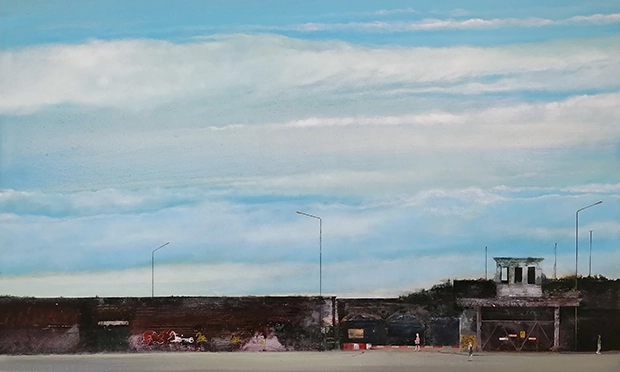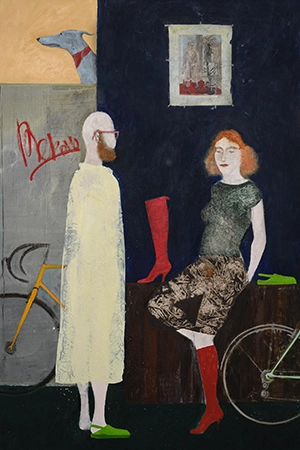‘It was a revelation in a selfish, personal way’: Artist Jock McFadyen on how his own retrospective gave him a ‘hankering to mix and match’

Red Yellow and Blue. Image: Jock McFadyen / courtesy Alexandra Bradley
Jock McFadyen showed me his paint brushes. They ranged from a tiny one resembling an eye-liner to a three-foot wide broom that you use to sweep large rooms.
He needs this variety given the stylistic range of his painting, which can contain in a single canvas sections of minute, almost photographic detail alongside swathes of near-abstraction.
As a Royal Academician who has been working in the capital for half a century, McFayden has seen huge changes both in the world of art and in the parts of East London where he lives and works.
He has in recent years been best known for his imposing landscapes of desolate margins of Hackney, Bethnal Green and surrounding areas.
In his current exhibition, Red Yellow and Blue: Four Pictures, on display at Grey Gallery, his studio-cum-exhibition space, he has returned also to painting people.
There is a colourful couple partly unshod with bicycles, another pair of faces in apparent dialogue, a solo man, female lips. Alongside these we see two panoramic landscapes, one of Shoreditch High Street and a second of graffiti on railway arches.
The Hackney Citizen caught up with McFadyen at the opening of this show to ask him about his recent work.

The Shore Ditch. Image: Jock McFadyen / courtesy Alexandra Bradley
HC: “Your paintings have long been relatively de-populated, and you’ve come back in your more recent work that is shown here to the human form, and I wonder what’s brought you back?”
JM: “That’s right. One of the exhibitions I had for my 70th birthday was a retrospective at the Lowry, and it had pictures I’d done in the 1970s. It wasn’t hung severely chronologically, but there was a room of very early things, there was a room of mid-period things and another room of the big empty landscapes, which are more what I do now. And it was sort of a bit like the thing where, you know, somebody’s having motorbike crash and they think they’re going die and their life flashes before them. So it really was a revelation to me, in a selfish personal way, and I thought: there is all this work, I did that, and I did this. You don’t have a chance to see that when you have exhibitions, you exhibit your recent work and then you do the next thing. The changes are so incremental, they’re small, and here it was displayed before my eyes. So when I got back here I still had this hankering to try and mix and match things better. I had been painting figurative paintings all the time. I just hadn’t been exhibiting them.
“They’ve always been there, these figurative paintings, and now they’ve come out. I experienced it at the Lowry. I put some of my pictures alongside Lowry, because he was another urban realist, if you like, so I identify with Lowry, because he had de-populated landscapes and intensely populated landscapes. And so he was also doing pictures of things that he saw in Salford. And here I am thinking: well, it’s mad not to have a sense of connection with other artists, stylistically different of course, but you know, travelling on parallel lines.
“I did start off in 2012 exhibiting figurative paintings. I did a lot of quite pornographic paintings which I exhibited in two houses in Princelet Street. I filled up these two early Georgian houses, Huguenot houses, with pictures which were of people having sex, or about to have sex. The reason for that show was because previously Sickert had the Camden Town paintings displayed at the Courtauld. I had thought, Sickert would have to do a lot more than a bloke with his clothes on with a naked woman in Camden. That might have shocked he Edwardians, but today, people wouldn’t be shocked, I thought: what would shock people? I painted them in an Edwardian style, with old frames. That was my first show of figurative paintings for a long time. Now I’m going to try and be as figurative as landscape.”

Hackney Interior. Image: Jock McFadyen / courtesy Alexandra Bradley
HC: “How do you choose the things that you paint? How you choose the locations?”
JM: “Instinct, really. It’s a bit like if you’re looking for a house to buy, or rent as young people would be doing now. Is a kind of Feng Shui thing, the way that the house sits on the road, or not on the road, or the way it faces and all that stuff. And I just see the thing and I think, oh great. And I can’t explain it more than that. It’s not certainly not a rational thing that could be talked about. And also, if there is a particular building, and I don’t think it’s in the right place, I might move it to another place, another landscape or an empty landscape that might need a building, which I have done quite recently with the picture of Blackmans Yard in Cheshire Street which I’ve painted a few times. And I moved it to an empty space because that little building is orange at the moment, but before that was a motorbike workshop. So that’s how I do it. Maybe it could just be if something looks pictorial, I’ve no idea. It could be, I just think: oh, I could get a good picture of that, and then manipulate it into something. It’s purely instinctive like that.
HC: “East London has changed a lot since you began painting it, and I wonder if those changes have altered the way you’ve engaged with the area.”
JM: “I’ve been here for 50 years. I was an art student in 1973. I was in Chelsea in a squat off the King’s Road. And then I went to Butler’s Wharf in 1977, which had 200 other artists in it. That was a big scene, a bit like Hackney Wick is now. Hackney is no stranger to artists, as you must know. It is difficult to see London through the prism of that, because you couldn’t paint a picture of Piccadilly Circus. Could you? Because it’s too iconic, it’s on chocolate tins and things. Or Tower Bridge. So when you make pictures about London, you’re really making pictures about the edges of it, and the edges are where it gives way to the landscape. So for me it’s the estuary. And, if it’s a billboard, like an advertising billboard, maybe it’s advertising a car or something. It’s a bit like going behind the billboard and seeing the six-inch nails sticking out and the screws and some rubbish at the back. And the landscape.
Jock McFadyen’s Red Yellow and Blue: Four Pictures runs until 14 May at Grey Gallery at Jock McFadyen Studio, 4 Helmsley Place, London Fields, E8 3SB on Saturdays and Sundays, 11am to 4pm or by appointment.
For more information, email info@thegreygallery.com.
